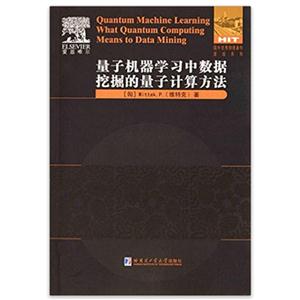量子机器学习中数据挖掘的量子计算方法
本书特色
[
《量子机器学习中数据挖掘的量子计算方法(英文版)》分三个部分对量子机器学习中数据挖掘的量子计算方法进行了介绍,第壹部分对基础概念进行了整体概述,例如,机器学习、量子力学、量子计算等,第二部分介绍了经典的学习算法,第三部分介绍了量子计算与机器学习。这本书综合了广泛的调查研究形成,采用简洁的表达形式,并配以应用、实践的例子。
]
内容简介
[
《量子机器学习中数据挖掘的量子计算方法(英文版)》由哈尔滨工业大学出版社出版。
]
目录
目录
Preface Notations PartOne FundamentaIConcepts 1 Introduction 1.1 Learning Theory and Data Mining 1.2 Why Quantum Computers? 1.3 A Heterogeneous Model 1.4 An Overview of Quantum Machine Learning Algorithms 1.5 Quantum—Like Learning on Classical Computers 2 Machine Learning 2.1 Data—DrivenModels 2.2 FeatureSpace 2.3 Supervised and Unsupervised Learning 2.4 GeneralizationPerformance 2.5 ModeIComplexity 2.6 Ensembles 2.7 Data Dependencies and ComputationalComplexity 3 Quantum Mechanics 3.1 States and Superposition 3.2 Density Matrix Representation and Mixed States 3.3 Composite Systems and Entanglement 3.4 Evolution 3.5 Measurement 3.6 UncertaintyRelations 3.7 Tunneling 3.8 Adiabatic Theorem 3.9 No—CloningTheorem 4 Quantum Computing 4.1 Qubits and the Bloch Sphere 4.2 QuantumCircuits 4.3 Adiabatic Quantum Computing 4.4 QuantumParallelism 4.5 Grover’s Algorithm 4.6 ComplexityClasses 4.7 QuantumInformationTheory Part Two ClassicalLearning Algorithms 5 Unsupervised Learning 5.1 Principal Component Analysis 5.2 ManifoldEmbedding 5.3 K—Means and K—Medians Clustering 5.4 HierarchicalClustering 5.5 Density—BasedClustering 6 Pattern Recogrution and Neural Networks 6.1 ThePerceptron 6.2 HopfieldNetworks 6.3 FeedforwardNetworks 6.4 DeepLearning 6.5 ComputationalComplexity 7 Supervised Learning and Support Vector Machines 7.1 K—NearestNeighbors 7.20ptimal Margin Classifiers 7.3 SoftMargins 7.4 Nonlinearity and KemelFunctions 7.5 Least—SquaresFormulation 7.6 Generalization Performance 7.7 Multiclass Problems 7.8 Loss Functions 7.9 ComputationalComplexity 8 Regression Analysis 8.1 Linear Least Squares 8.2 NonlinearRegression 8.3 NonparametricRegression 8.4 ComputationalComplexity 9 Boosting 9.1 WeakClassifiers 9.2 AdaBoost 9.3 A Family of Convex Boosters 9.4 Nonconvex Loss Functions Part Three Quantum Computing and Machine Learning 10 Clustering Structure and Quantum Computing 10.1 Quantum Random Access Memory 10.2 Calculating Dot Products 10.3 Quantum Principal Component Analysis 10.4 Toward Quantum Manifold Embedding 10.5 QuantumK—Means 10.6 QuantumK—Medians 10.7 Quantum Hierarchical Clustering 10.8 ComputationalComplexity 11 Quantum Pattern Recognition 11.1 Quantum Associative Memory 11.2 The Quantum Perceptron 11.3 Quantum Neural Networks 11.4 PhysicaIRealizations 11.5 ComputationalComplexity 12 QuantumClassification 12.1 Nearest Neighbors 12.2 Support Vector Machines with Grover’s Search 12.3 Support Vector Machines with Exponential Speedup 12.4 ComputationalComplexity 13 Quantum Process Tomography and Regression 13.1 Channel—State Duality 13.2 Quantum Process Tomography 13.3 Groups, Compact Lie Groups, and the Unitary Group 13.4 Representation Theory 13.5 Parallel Application and Storage of the Unitary 13.6 Optimal State for Learning 13.7 Applying the Unitary and Finding the Parameter for the Input State 14 Boosting and Adiabatic Quantum Computing 14.1 Quantum Annealing 14.2 Quadratic Unconstrained Binary Optimization 14.3 Ising Model 14.4 QBoost 14.5 Nonconvexity 14.6 Sparsity, Bit Depth, and Generalization Performance 14.7 Mapping to Hardware 14.8 ComputationalComplexity Bibliography
封面

书名:量子机器学习中数据挖掘的量子计算方法
作者:维特克
页数:163
定价:¥98.0
出版社:哈尔滨工业大学出版社
出版日期:2016-01-01
ISBN:9787560357591
PDF电子书大小:49MB 高清扫描完整版
